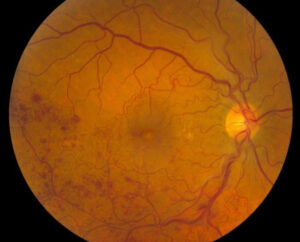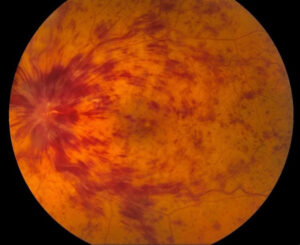Retinal Vein Occlusion
This disorder is caused by blockage of a retinal vein leading to hemorrhaging and leakage of damaged blood vessels in the area of the blockage. Most retinal vein occlusions are associated with arteriosclerosis (hardening of the arteries) causing compression of the affected vein by an adjacent artery. Patients experience varying degrees of visual loss depending on the location and severity of the vein occlusion. If the macula (the central retina) is not involved, the patient may be asymptomatic and unaware of the problem.
Common risk factors for vein occlusions include high blood pressure, elevated cholesterol, being overweight, a history of cardiovascular disease, glaucoma, and blood disorders causing abnormal clotting.
There are two categories of retinal vein occlusions:

By Jason S. Calhoun from Retina Image Bank, 2013
Branch Retina Vein Occlusion – when a small retinal vein becomes blocked thus affecting a portion of the retina.

By Jason S. Calhoun from Retina Image Bank, 2013
Central Retinal Vein Occlusion – when the main vein supplying the retina becomes blocked and causing diffuse retinal hemorrhaging throughout the retina.
Treatment
The retinal vein occlusion itself is not treatable but may resolve if an underlying condition such as hypertension is identified and treated. Thus, it is of primary importance to determine and treat the underlying condition leading to the retinal vein occlusion. A thorough and comprehensive evaluation, often with the assistance of the patient’s primary care physician, is essential to identify modifiable risk factors of arteriosclerosis such as uncontrolled high blood pressure, elevated cholesterol, etc. In younger patients, an evaluation for sources of abnormal blood clotting may be recommended.
Secondary complications of vein occlusions, most commonly macular edema and abnormal retinal and iris blood vessel growth (neovascularization) can be treated with intravitreal injections of anti-vascular endothelial growth factor medications. Prior to the availability of these medications, patients often experienced significant loss of vision from this disease. Now these injectable medications are vital to maintaining vision and are considered the standard of care. Laser treatment remains useful in selected cases.

